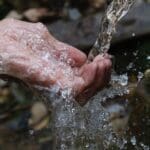About 72% of the Earth’s surface is covered by water – but only 3% of the water on Earth is fresh and fit for human consumption.
We depend on water for various reasons, so keeping our fresh water supply clean and free from harmful contamination is paramount. With the proper infrastructure, though, the water we bring into our homes for drinking, cooking, and cleaning can protect our health.
Keeping water clean – and keeping us safe from nasty chemicals, biological hazards, and other potentially harmful matters – is the water industry’s biggest priority. On a daily basis, here is how the water is kept safe and secure.

The Challenges of Water Contamination
Fighting contamination first means understanding it.
Humans are remarkably resilient, but our immune systems can only handle so much. Water can be an excellent conduit for organic and non-organic contaminants to invade our bodies and potentially wreak havoc.
In the U.S., a contaminant is legally defined as “any physical, chemical, biological, or radiological substance or matter in water” – in short, anything that isn’t water itself. Not all contaminants are harmful, and eliminating 100% of contamination from a water supply is impossible.
However, when a harmful contaminant is in the water supply above a certain level, people can become sick with anything from an acute, short-lived illness to potentially a chronic condition. Lead, for example, can seriously damage our brains and kidneys and hamper our body’s ability to produce life-giving red blood cells.
Fighting the good fight against contamination is a challenge because over 90 chemical, physical, or microbial agents are viewed as harmful enough to be tracked by the Environmental Protection Agency. That’s a long list.
Detecting contamination is easy enough with the right tools, a regular inspection schedule, and constant vigilance. Still, the U.S. water system is massive – which means ongoing inspection of the untold miles of pipes and countless delivery systems is virtually impossible.
The first line of defense is designing safer equipment and materials that get water from where it is to where we need it: in our homes.
How Today’s Equipment and Technology Protect Our Water
The science of water transportation has come a long way from the simple terra-cotta and wooden pipework of yesteryear.
Today, the industry uses a combination of high-tech materials and innovative components to construct systems that are not only reliable – thus helping to prevent catastrophic pipe bursts and other structural failures – but as contaminant-free as possible.
For example, Spec Rubber produces rubber gaskets for water pipes that comply with NSF-61, the national standard for water safety in components designed to come in contact with our fresh water supply. The appropriately named NSF-61 flat gaskets are constructed from an EPDM rubber compound manufactured according to the rigorous ISO 9001:2015 quality control standards.
By meeting (and exceeding) these standards, our American-made gaskets can sustainably and reliably protect water as it is transported through the structural networks we enable – thus helping to protect it from contamination that otherwise would threaten our health.
To further help in the fight, the water industry employs sophisticated ways to treat and purify water that improve in effectiveness as technology continues to advance. Fresh water that goes through a public water treatment facility is made progressively cleaner for use through coagulation, flocculation, sedimentation, filtration, and disinfection. (For more info on these steps, check out this handy guide from the Centers for Disease Control.)
Thanks to hard work and American ingenuity, our nation has some of the safest drinking water in the world.
Ensuring Safe Water Not Just Today, but Tomorrow
As stewards of our environment, we have a duty to protect drinking water not just for today’s families but for those of the future – for the next generation and every generation after.
Sustainable, environmentally friendly American manufacturing processes help maintain cleanliness inside and outside the water system. Even if the pipes and gaskets that carry water are clean, toxic chemicals can still leach into the groundwater if not properly handled and disposed of.
The molded rubber industry hasn’t always been kind to the environment. At Spec Rubber, though, we’ve built a reputation for using processes that are as safe for the environment as they are for our teammates and the families we support.
We also support clean water initiatives and industry best practices that don’t sacrifice the environment for quality or efficiency.
We encourage you to do your part to keep our drinking water clean by getting involved in the community. Find and reach out to a local watershed protection group and learn more about volunteering. You can also follow these simple guidelines to manage how you interact with water on an individual level and be a part of the solution.
In conclusion, clean water matters, and we can’t live without it. Spec Rubber will continue to innovate better ways to be a part of our nation’s water delivery infrastructure, manufacturing the best, most sustainable gaskets that our families can rely on.
We’re all in this together when it comes to protecting our freshwater supply. We all need clean water, and to stay clean, water needs us.







